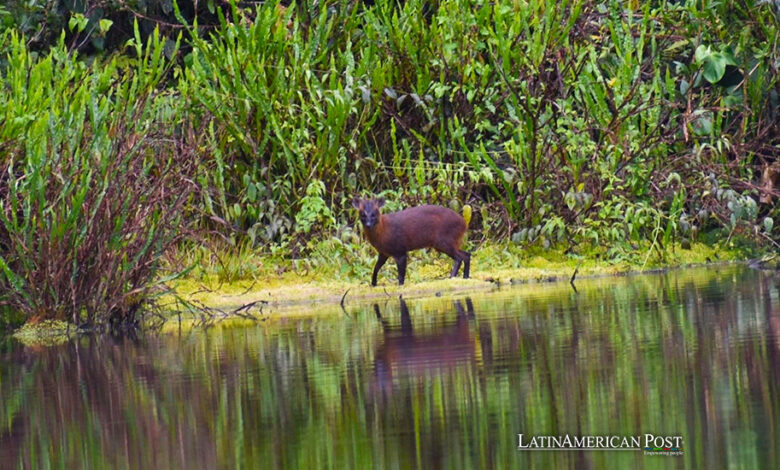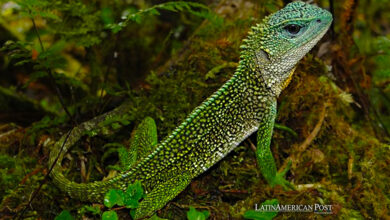A New Deer Species Discovered in Peru’s Forests

In the verdant forests of Piura, northern Peru, a groundbreaking discovery has been made—a new species of deer, locally known as pudú. This discovery reveals Latin America’s rich biodiversity and sparks a call for enhanced conservation efforts.
Exploring Latin America’s Ecological Riches
In the lush expanses of Latin America, where biodiversity thrives amidst ancient cultures and civilizations, a recent scientific breakthrough has spotlighted the region’s ecological wealth. In the northern Peruvian region of Piura, a collaborative effort by Peruvian, Chilean, and Brazilian scientists has led to the discovery of a new species of dwarf deer, locally known as pudú. This discovery enriches our understanding of Latin America’s fauna and emphasizes the importance of cross-border collaboration in preserving the continent’s natural heritage.
Published in the Journal of Mammalogy, the study “First Living Deer Species Described in the 21st Century and Revalidation of Pudella” marks a significant milestone in zoological research. Through a combination of qualitative and quantitative morphological analyses and assessments of genetic variation, the research team has revealed a species that had remained hidden within the dense foliage of Peru’s forests.
Hidden Treasures in Peru’s Forests
The National Service of Natural Protected Areas by the State of Peru (Sernanp) announced that this research differentiates what was previously considered a single species, Pudu Mephistopheles, into two distinct species. One, Pudella mephistophila, resides in the northern part of the Huancabamba depression in Piura, while the other, Pudella carlae, is found to the south.
Pudella carlae, in particular, stands as the first living deer species described in the 21st century and the first in the New World in over 60 years—a testament to the untold stories that Latin America’s ecosystems hold. Characterized by its short legs, this small deer is endemic to Peru, spreading from the southeast of the Huancabamba depression through the Peruvian yungas (dwarf and cloud forests) along the northern and central eastern side of the Peruvian Andes.
This newfound species calls several of Peru’s protected areas home, including the Rio Abiseo National Park, Yanachaga Chemillén National Park, Pampa Hermosa National Sanctuary, Cordillera del Colán National Sanctuary, Pui Pui Protection Forest, Alto Mayo Protection Forest, and Chayu Nain Communal Reserve. Pudella carlae’s distribution across these varied ecosystems underscores the critical role that protected areas play in the conservation of biodiversity and the survival of unique species.
The discovery of Pudella carlae is a clarion call for strengthened management of the natural protected areas where it resides. Sernanp emphasizes the need to identify threats to the species, conduct studies on its conservation status, biology, and ecology, and implement measures to ensure its preservation for future generations. This approach aligns with broader conservation strategies across Latin America, where biodiversity protection is increasingly recognized as paramount for sustainable development and ecological balance.
Latin America’s history of biodiversity conservation is rich and complex, shaped by indigenous knowledge, colonial legacies, and modern scientific inquiry. The discovery of new species like Pudella carlae adds to the scientific understanding of the region’s ecological diversity and highlights the importance of preserving its natural habitats. As Latin America faces deforestation, climate change, and urbanization challenges, identifying and protecting unique species becomes even more crucial.
The collaboration among scientists from Peru, Chile, and Brazil in uncovering Pudella carlae exemplifies the potential of regional cooperation in addressing environmental and conservation challenges. By pooling resources, expertise, and knowledge, Latin American countries can better protect their shared biodiversity and promote a unified front against ecological threats.
Untapped Mysteries and Ongoing Exploration
Furthermore, this discovery reminds us of the untapped mysteries within Latin America’s forests and the need for continued exploration and research. With vast areas of the continent still relatively unexplored, the potential for finding new species and understanding ecological dynamics is immense. Such discoveries enrich the global biodiversity catalog and provide valuable insights into conservation strategies and the environmental roles of various species.
Also read: Peru Battles Dengue Outbreak Declaring Health Emergency: A Wake-Up Call for Latin America
Unveiling Pudella care in Peru’s forests is more than just a scientific achievement; it is a testament to Latin America’s rich biodiversity and a call to action for conservation. As the region navigates the challenges of the 21st century, protecting its unique ecosystems and species will be paramount. Through collaboration, research, and dedicated conservation efforts, Latin America can ensure that its natural heritage is preserved for generations to come, offering hope and inspiration for a more sustainable and biodiverse future.




